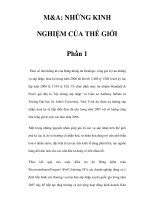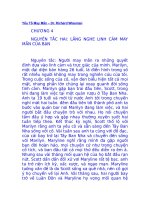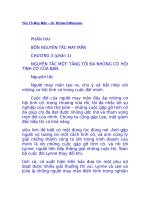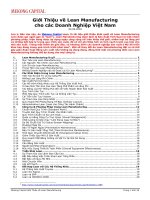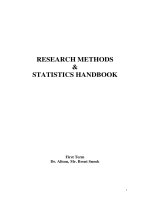ree to choose a personal statement phần 1 pot
Bạn đang xem bản rút gọn của tài liệu. Xem và tải ngay bản đầy đủ của tài liệu tại đây (225.88 KB, 35 trang )
Copyright © 1980, 1979 by Milton Friedman
and Rose D. Friedman
All rights reserved. No part of
this publication may be reproduced or
transmitted in any form or by any means,
electronic or mechanical, including photocopy,
recording, or any information storage and
retrieval system, without permission
in writing from the publisher.
Requests for permission to make copies of
any part of the work should be mailed to:
Permissions, Harcourt Brace Jovanovich, Inc.
757 Third Avenue, New York, N.Y. 10017
The author wishes to thank the following publishers for per-
mission to quote from the sources listed:
Harvard Educational Review.
Excerpts from "Alternative Pub-
lic
School Systems" by Kenneth B. Clark in the
Harvard Edu-
cational Review,
Winter 1968. Reprinted by permission of the
publisher.
Newsweek
Magazine. Excerpt from "Barking Cats
"
by Milton
Friedman in
Newsweek
Magazine, February 19, 1973. Copy-
right
© 1973 by Newsweek, Inc. All rights reserved. Reprinted
by permission.
The
Wall Street Journal.
Excerpts from "The Swedish Tax
Revolt" by Melvyn B. Krauss in
The
Wall Street Journal,
February 1, 1979. Reprinted by permission of The Wall Street
Journal,
© Dow Jones & Co., Inc., 1979. All rights reserved.
Set in Linotype Times Roman
Printed in the United States of America
Library of Congress Cataloging in Publication Data
Friedman, Milton, 1912–
Free to choose.
Includes bibliographical references and index.
1.
Capitalism.
2.
Welfare state.
3. Industry and state. I. Friedman, Rose D.,
joint author.
II.
Title.
HB501.F72
330.12'2
79-1821
ISBN
0-15-133481-1
L M
PRICE THEORY
THERE IS NO SUCH THING AS A FREE LUNCH
AN ECONOMIST'S PROTEST
THE OPTIMUM QUANTITY OF MONEY
AND OTHER ESSAYS
DOLLARS AND DEFICITS
A MONETARY HISTORY OF THE UNITED STATES
(with Anna J. Schwartz)
INFLATION: CAUSES AND CONSEQUENCES
With Rose Friedman
CAPITALISM AND FREEDOM
To Ricky and Patri
CONTENTS
PREFACE
INTRODUCTION
ix
1
CHAPTER
I
The Power of the Market
9
CHAPTER
2
The Tyranny of Controls
38
CHAPTER
3
The Anatomy of Crisis
70
CHAPTER
4
Cradle to Grave
91
CHAPTER
5
Created Equal
128
CHAPTER
6
What's Wrong with Our Schools?
150
CHAPTER
7
Who Protects the Consumer?
189
CHAPTER
8
Who Protects the Worker?
228
CHAPTER
9
The Cure for Inflation
248
CHAPTER
IO
The Tide Is Turning
283
APPENDICES
311
NOTES
315
INDEX 327
vii
PREFACE
This book has two parents:
Capitalism and Freedom,our earlier
book, published in 1962 (University of Chicago Press) ; and a
TV series, titled, like the book, "Free to Choose." The series will
be shown on the Public Broadcasting Service for ten successive
weeks in 1980.
Capitalism and Freedom
examines "the role of competitive
capitalism—the organization of the bulk of economic activity
through private enterprise operating in a free market—as a sys-
tem of economic freedom and a necessary condition for political
freedom." In the process, it defines the role that government
should play in a free society.
"Our principles offer,"
Capitalism and Freedom
says, "no hard
and fast line how far it is appropriate to use government to accom-
plish jointly what it is difficult or impossible for us to accomplish
separately through strictly voluntary exchange. In any particular
case of proposed intervention, we must make up a balance sheet,
listing separately the advantages and disadvantages. Our principles
tell us what items to put on the one side and what items on the
other and they give us some basis for attaching importance to the
different items."
To give substance to those principles and illustrate their ap-
plication,
Capitalism and Freedom
examines specific issues—
among others, monetary and fiscal policy, the role of government
in education, capitalism and discrimination, and the alleviation
of poverty.
Free to Choose is
a less abstract and more concrete book.
Readers of
Capitalism and Freedom
will find here a fuller de-
velopment of the philosophy that permeates both books—here,
there are more nuts and bolts, less theoretical framework. More-
over, this book is influenced by a fresh approach to political sci-
ence that has come mainly from economists—Anthony Downs,
ix
x
FREE TO CHOOSE: A Personal Statement
James M. Buchanan, Gordon Tullock, George J. Stigler, and
Gary S. Becker, who, along with many others, have been doing
exciting work in the economic analysis of politics.
Free to Choose
treats the political system symmetrically with the economic sys-
tem. Both are regarded as markets in which the outcome is
determined by the interaction among persons pursuing their own
self-interests (broadly interpreted) rather than by the social goals
the participants find it advantageous to enunciate. That is implicit
throughout the book and explicit in the final chapter.
The TV series covers the same topics as this book: the ten
chapters of the book correspond to the ten programs of the TV
series and (except for the final chapter) bear the same titles.
However, the TV series and the book are very different—each
true to its own character. The book covers many items that the
ti
me constraints of the TV programs made it necessary to omit
or allude to only briefly. And its coverage is more systematic and
thorough.
We were induced to undertake the TV series in early 1977 by
Robert Chitester, president of PBS station WQLN of Erie, Penn-
sylvania. His imagination and hard work, and his commitment to
the values of a free society, made the series possible. At his sug-
gestion,
Milton presented between September of 1977 and May
of 1978 fifteen public lectures before various audiences followed
by question-and-answer sessions, all of which were videotaped.
William Jovanovich committed Harcourt Brace Jovanovich to the
marketing of the videotapes and provided a generous advance to
help finance the videotaping of the lectures, which are currently
being distributed by Harcourt Brace Jovanovich, Inc. The tran-
scripts of the lectures served as raw material for designing the
TV programs themselves.
Before the lectures were completed, Bob Chitester had suc-
ceeded in obtaining sufficient financial support to permit us to
proceed with the TV series. We selected Video-Arts of London
as the best group to produce it. After months of preliminary
planning, actual filming began in March of 1978 and was not
completed until September of 1979.
Anthony Jay, Michael Peacock, and Robert Reid of Video-
Arts played a key role in the initial design of the series and an
i
mportant supervisory role thereafter.
Preface
xi
Five TV professionals were with us throughout most of the
filming and editing: Michael Latham, as producer of the series;
Graham Massey, as film director; Eben Wilson, as an associate
producer and principal researcher; Margaret Young, as assistant
film director and production secretary; and Jackie Warner, as
production manager. They initiated us gently but firmly into the
arcane art of making TV documentaries and smoothed over the
difficult spots with invariable tact and friendship. They made our
venture into a strange and complex world an exciting and enjoy-
able experience rather than the nightmare that we now realize it
could easily have become.
Their insistence on combining brevity with both rigor and lucid-
ity forced us to rethink many of our own ideas and to pare them
down to essentials. The discussions with them, as well as with the
film crews from different countries—one of the most enjoyable
parts of the project—helped us to recognize weak points in our
reasoning and induced us to search for further evidence. Released
from the rigid time constraints of TV, we have been able to take
full advantage of these discussions in this book.
We are in debt to Edward C. Banfield and David D. Friedman,
who read the complete first draft, and to George Stigler, Aaron
Director, Chiaki Nishiyama, Colin Campbell, and Anna Schwartz.
Rosemary Campbell spent many hours of painstaking work in the
library checking facts and figures. We cannot blame her if errors
do appear, for we did some of the checking ourselves. We owe
much to Gloria Valentine, Milton's secretary, whose good nature
is
matched by her competence. Finally, we appreciate the help we
have received from Harcourt Brace Jovanovich, some anony-
mously, some from William Jovanovich, Carol Hill, and our
editor,
Peggy Brooks.
Television is dramatic. It appeals to the emotions. It captures
your attention. Yet, we remain of the opinion that the printed
page is a more effective instrument for both education and per-
suasion. The authors of a book can explore issues deeply—with-
out being limited by the ticking clock. The reader can stop and
think, turn the pages back without being diverted by the emo-
tional appeal of the scenes moving relentlessly across his televi-
sion screen.
Anyone who is persuaded in one evening (or even ten one-hour
xii
Preface
evenings) is not really persuaded. He can be converted by the
next person of opposite views with whom he spends an evening.
The only person who can truly persuade you is yourself. You
must turn the issues over in your mind at leisure, consider the
many arguments, let them simmer, and after a long time turn
your preferences into convictions.
Milton Friedman
Rose D. Friedman
Ely, Vermont
September 28, 1979
"Experience should teach us to be most on our guard to
protect liberty when the government's purposes are bene-
ficial.
Men born to freedom are naturally alert to repel
invasion of their liberty by evil-minded rulers. The
greater dangers to liberty lurk in insidious encroachment
by
men of zeal, well-meaning but without under-
standing."
—Justice Louis Brandeis,
Olmstead v. United States,
277 U.S. 479 (1928)
INTRODUCTION
Ever since the first settlement of Europeans in the New World
America has been a magnet for people seeking adventure, fleeing
from tyranny, or simply trying to make a better life for themselves
and their children.
An initial trickle swelled after the American Revolution and
the establishment of the United States of America and became
a flood in the nineteenth century, when millions of people
streamed across the Atlantic, and a smaller number across the
Pacific, driven by misery and tyranny, and attracted by the
promise of freedom and affluence.
When they arrived, they did not find streets paved with gold;
they did not find an easy life. They did find freedom and an op-
portunity to make the most of their talents. Through hard work,
ingenuity, thrift, and luck, most of them succeeded in realizing
enough of their hopes and dreams to encourage friends and rela-
tives to join them.
The story of the United States is the story of an economic
miracle and a political miracle that was made possible by the
translation into practice of two sets of ideas—both, by a curious
coincidence, formulated in documents published in the same year,
1776.
One set of ideas was embodied in
The Wealth of Nations,
the
masterpiece that established the Scotsman Adam Smith as the
father of modern economics. It analyzed the way in which a
market system could combine the freedom of individuals to pur-
sue their own objectives with the extensive cooperation and col-
laboration needed in the economic field to produce our food, our
clothing, our housing. Adam Smith's key insight was that both
parties to an exchange can benefit and that,
so long as cooperation
is
strictly
voluntary,
no exchange will take place unless both
1
2
FREE TO CHOOSE: A Personal Statement
parties do benefit. No external force, no coercion, no violation
of freedom is necessary to produce cooperation among indi-
viduals all of whom can benefit. That is why, as Adam Smith put
it,
an individual who "intends only his own gain" is "led by an
invisible hand to promote an end which was no part of his inten-
tion.
Nor is it always the worse for the society that it was no part
of it. By pursuing his own interest he frequently promotes that
of the society more effectually than when he really intends to
promote it. I have never known much good done by those who
affected to trade for the public good."
1
The second set of ideas was embodied in the Declaration of
Independence, drafted by Thomas Jefferson to express the general
sense of his fellow countrymen. It proclaimed a new nation, the
first in history established on the principle that every person is
entitled to pursue his own values: "We hold these truths to be
self-evident, that all men are created equal, that they are endowed
by their Creator with certain unalienable Rights; that among
these are Life, Liberty, and the pursuit of Happiness."
Or, as stated in more extreme and unqualified form nearly a
century later by John Stuart Mill,
The sole end for which mankind are warranted, individually or col-
lectively, in interfering with the liberty of action of any of their
number, is self protection. . . . [T]he
only purpose for which power
can be rightfully exercised over any member of a civilized commu-
nity, against his will, is to prevent harm to others. His own good,
either physical or moral, is not a sufficient warrant. . . . The only
part of the conduct of any one, for which he is amenable to society,
is
that
which concerns others. In the part which merely concerns
himself, his independence is, of right, absolute. Over himself, over his
own body and mind, the individual is
sovereign.
2
Much of the history of the United States revolves about the
attempt to translate the principles of the Declaration of Inde-
pendence into practice—from the struggle over slavery, finally
settled by a bloody civil war, to the subsequent attempt to promote
equality of opportunity, to the more recent attempt to achieve
equality of results.
Economic freedom is an essential requisite for political free-
dom. By enabling people to cooperate with one another without
lntroduction
3
coercion or central direction, it reduces the area over which politi-
cal power is exercised. In addition, by dispersing power, the free
market provides an offset to whatever concentration of political
power may arise. The combination of economic and political
power
in the same hands is a sure recipe for tyranny.
The combination of economic and political
freedom
produced
a golden age in both Great Britain and the United States in the
nineteenth century. The United States prospered even more than
Britain. It started with a clean slate: fewer vestiges of class and
status; fewer government restraints; a more fertile field for energy,
drive, and innovation; and an empty continent to conquer.
The fecundity of freedom is demonstrated most dramatically
and clearly in agriculture. When the Declaration of Independence
was enacted, fewer than
3
million persons of European and Afri-
can origin (i.e., omitting the native Indians) occupied a narrow
fringe along the eastern coast. Agriculture was the main economic
activity. It took nineteen out of twenty workers to feed the
country's inhabitants and provide a surplus for export in exchange
for foreign goods. Today it takes fewer than one out of twenty
workers to feed the 220 million inhabitants and provide a surplus
that makes the United States the largest single exporter of food
in the world.
What produced this miracle? Clearly not central direction by
government—nations like Russia and its satellites,
mainland
China, Yugoslavia, and India that today rely on central direction
employ from one-quarter to one-half of their workers in agri-
culture, yet frequently rely on U.S. agriculture to avoid mass
starvation.
During most of the period of rapid agricultural ex-
pansion in the United States the government played a negligible
role.
Land was made available—but it was land that had been
unproductive before. After the middle of the nineteenth century
land-grant colleges were established, and they disseminated in-
formation and technology through governmentally financed ex-
tension services. Unquestionably, however, the main source of the
agricultural revolution was private initiative operating in a free
market open to all—the shame of slavery only excepted. And
the
most rapid growth came after slavery was abolished. The
millions of immigrants from all over the world were free to work
4
FREE TO CHOOSE: A Personal Statement
for themselves, as independent farmers or businessmen, or to work
for others, at terms mutually agreed. They were free to experi-
ment with new techniques—at their risk if the experiment failed,
and to their profit if it succeeded. They got little assistance from
government. Even more important, they encountered little in-
terference from government.
Government started playing a major role in agriculture during
and after the Great Depression of the 1930s. It acted primarily to
restrict output in order to keep prices artificially high.
The growth of agricultural productivity depended on the ac-
companying industrial revolution that freedom stimulated. Thence
came the new machines that revolutionized agriculture. Con-
versely, the industrial revolution depended on the availability of
the
manpower released by the agricultural revolution. Industry
and agriculture marched hand in hand.
Smith and Jefferson alike had seen concentrated government
power as a great danger to the ordinary man; they saw the pro-
tection of the citizen against the tyranny of government as the per-
petual need. That was the aim of the Virginia Declaration of
Rights (1776) and the United States Bill of Rights (1791) ; the
purpose of the separation of powers in the U.S. Constitution; the
moving force behind the changes in the British legal structure
from the issuance of the Magna Carta in the thirteenth century to
the end of the nineteenth century. To Smith and Jefferson, gov-
ernment's role was as an umpire, not a participant. Jefferson's
ideal, as he expressed it in his first inaugural address (1801) , was
"[a]
wise and frugal government, which shall restrain men from
injuring one another, which shall leave them otherwise free to
regulate their own pursuits of industry and improvement."
Ironically, the very success of economic and political freedom
reduced its appeal to later thinkers. The narrowly limited govern-
ment of the late nineteenth century possessed little concentrated
power that endangered the ordinary man. The other side of that
coin was that it possessed little power that would enable good
people to do good. And in an imperfect world there were still
many evils. Indeed, the very progress of society made the residual
evils seem all the more objectionable. As always, people took the
favorable developments for granted. They forgot the danger to
Introduction
5
freedom from a strong government. Instead, they were attracted
by the good that a stronger government could achieve—if only
government power were in the "right" hands.
These ideas began to influence government policy in Great
Britain by the beginning of the twentieth century. They gained
increasing acceptance among intellectuals in the United States
but had little effect on government policy until the Great De-
pression of the early 1930s. As we show in Chapter 3, the depres-
sion was produced by a failure of government in one area—money
—where it had exercised authority ever since the beginning of
the Republic. However, government's responsibility for the de-
pression was not recognized—either then or now. Instead, the
depression was widely interpreted as a failure of free market
capitalism. That myth led the public to join the intellectuals in a
changed view of the relative responsibilities of individuals and
government. Emphasis on the responsibility of the individual for
his own fate was replaced by emphasis on the individual as a
pawn buffeted by forces beyond his control. The view that gov-
ernment's role is to serve as an umpire to prevent individuals from
coercing one another was replaced by the view that government's
role is to serve as a parent charged with the duty of coercing
some to aid others.
These views have dominated developments in the United States
during the past half-century. They have led to a growth in govern-
ment at all levels, as well as to a transfer of power from local
government and local control to central government and central
control. The government has increasingly undertaken the task of
taking from some to give to others in the name of security and
equality. One government policy after another has been set up to
"regulate" our "pursuits of industry and improvement," standing
Jefferson's dictum on its head (Chapter 7).
These developments have been produced by good intentions
with a major assist from self-interest. Even the strongest support-
ers of the welfare and paternal state agree that the results have
been disappointing. In the government sphere, as in the market,
there seems to be an invisible hand, but it operates in precisely
the opposite direction from Adam Smith's: an individual who in-
tends only to serve the public interest by fostering government
6
FREE TO CHOOSE: A Personal Statement
intervention is "led by an invisible hand to promote" private in-
terests, "which was no part of his intention." That conclusion is
driven home again and again as we examine, in the chapters that
follow, the several areas in which government power has been
exercised—whether to achieve security (Chapter 4) or equality
(Chapter 5), to promote education (Chapter 6), to protect the
consumer (Chapter 7) or the worker (Chapter 8), or to avoid
inflation and promote employment (Chapter 9).
So far, in Adam Smith's words, "the uniform, constant, and
uninterrupted effort of every man to better his condition, the
principle from which public and national, as well as private
opulence is originally derived," has been "powerful enough to
maintain the natural progress of things toward improvement, in
spite both of the extravagance of governments and of the greatest
errors of administration. Like the unknown principle of animal
life, it frequently restores health and vigour to the constitution,
in spite, not only of the disease, but of the absurd prescriptions of
the doctor."
8
So far, that is, Adam Smith's invisible hand has been
powerful enough to overcome the deadening effects of the invisible
hand that operates in the political sphere.
The experience of recent years—slowing growth and declining
productivity—raises a doubt whether private ingenuity can con-
tinue to overcome the deadening effects of government control if
we continue to grant ever more power to government, to author-
ize a "new class" of civil servants to spend ever larger fractions
of our income supposedly on our behalf. Sooner or later—and
perhaps sooner than many of us expect—an ever bigger govern-
ment would destroy both the prosperity that we owe to the free
market and the human freedom proclaimed so eloquently in the
Declaration of Independence.
We have not yet reached the point of no return. We are still
free as a people to choose whether we shall continue speeding
down the "road to serfdom," as Friedrich Hayek entitled his pro-
found and influential book, or whether we shall set tighter limits
on government and rely more heavily on voluntary cooperation
among free individuals to achieve our several objectives. Will our
golden age come to an end in a relapse into the tyranny and
misery that has always been, and remains today, the state of most
lntroduction
7
of mankind? Or shall we have the wisdom, the foresight, and the
courage to change our course, to learn from experience, and to
benefit from a "rebirth of freedom"?
If
we are to make that choice wisely, we must understand the
fundamental principles of our system, both the economic prin-
ciples of Adam Smith, which explain how it is that a complex,
organized, smoothly running system can develop and flourish
without central direction, how coordination can be achieved
without coercion (Chapter 1) ; and the political principles ex-
pressed by Thomas Jefferson (Chapter 5). We must understand
why it is that attempts to replace cooperation by central direction
are capable of doing so much harm (Chapter 2). We must under-
stand also the intimate connection between political freedom and
economic freedom.
Fortunately, the tide is turning. In the United States, in Great
Britain, the countries of Western Europe, and in many other
countries around the world, there is growing recognition of the
dangers of big government, growing dissatisfaction with the pol-
icies that have been followed. This shift is being reflected not
only in opinion, but also in the political sphere. It is becoming
politically profitable for our representatives to sing a different
tune—and perhaps even to act differently. We are experiencing
another major change in public opinion. We have the opportunity
to nudge the change in opinion toward greater reliance on indi-
vidual initiative and voluntary cooperation, rather than toward
the other extreme of total collectivism.
In our final chapter, we explore why it is that in a supposedly
democratic political system special interests prevail over the gen-
eral interest.
We explore what we can do to correct the defect in
our system that accounts for that result, how we can limit govern-
ment while enabling it to perform its essential functions of de-
fending the nation from foreign enemies, protecting each of us
from coercion by our fellow citizens, adjudicating our disputes,
and enabling us to agree on the rules that we shall follow.
CHAPTER 1
The Power
of the Market
Every day each of us uses innumerable goods and services—to
eat, to wear, to shelter us from the elements, or simply to enjoy.
We take it for granted that they will be available when we want
to buy them. We never stop to think how many people have
played a part in one way or another in providing those goods and
services.
We never ask ourselves how it is that the corner grocery
store—or nowadays, supermarket—has the items on its shelves
that we want to buy, how it is that most of us are able to earn the
money to buy those goods.
It is natural to assume that someone must give orders to make
sure that the "right" products are produced in the "right" amounts
and available at the "right" places. That is one method of
coordinating the activities of a large number of people—the
method of the army. The general gives orders to the colonel, the
colonel to the major, the major to the lieutenant, the lieutenant to
the sergeant, and the sergeant to the private.
But that command method can be the exclusive or even prin-
cipal method of organization only in a very small group. Not even
the most autocratic head of a family can control every act of other
family members entirely by order. No sizable army can really be
run entirely by command. The general cannot conceivably have
the information necessary to direct every movement of the low-
liest private. At every step in the chain of command, the soldier,
whether officer or private, must have discretion to take into
account information about specific circumstances that his com-
manding officer could not have. Commands must be supplemented
by voluntary cooperation—a less obvious and more subtle, but
far
more fundamental, technique of coordinating the activities
of large numbers of people.
Russia is the standard example of a large economy that is sup-
posed to be organized by command—a centrally planned econ-
9
10
FREE TO CHOOSE: A Personal Statement
omy. But that is more fiction than fact. At every level of the
economy, voluntary cooperation enters to supplement central
planning or to offset its rigidities—sometimes legally, sometimes
illegally.'
In agriculture, full-time workers on government farms are per-
mitted to grow food and raise animals on small private plots in
their spare time for their own use or to sell in relatively free
markets. These plots account for less than 1 percent of the agri-
cultural land in the country, yet they are said to provide nearly a
third of total farm output in the Soviet Union (are "said to" be-
cause it is likely that some products of government farms are
clandestinely marketed as if from private plots).
In the labor market individuals are seldom ordered to work
at specific jobs; there is little actual direction of labor in this
sense. Rather, wages are offered for various jobs, and individuals
apply for them—much as in capitalist countries. Once hired, they
may subsequently be fired or may leave for jobs they prefer.
Numerous restrictions affect who may work where, and, of course,
the laws prohibit anyone from setting up as an employer—al-
though numerous clandestine workshops serve the extensive black
market. Allocation of workers on a large scale primarily by com-
pulsion is just not feasible; and neither, apparently, is complete
suppression of private entrepreneurial activity.
The attractiveness of different jobs in the Soviet Union often
depends on the opportunities they offer for extralegal or illegal
moonlighting. A resident of Moscow whose household equipment
fails
may have to wait months to have it repaired if he calls the
state repair office. Instead, he may hire a moonlighter—very likely
someone who works for the state repair office. The householder
gets his equipment repaired promptly; the moonlighter gets some
extra income. Both are happy.
These voluntary market elements flourish despite their in-
consistency with official
Marxist ideology because the cost of
eliminating them would be too high. Private plots could be for-
bidden—but the famines of the 1930s are a stark reminder of the
cost.
The Soviet economy is hardly a model of efficiency now.
Without the voluntary elements it would operate at an even lower
level of effectiveness. Recent experience in Cambodia tragically
illustrates the cost of trying to do without the market entirely.
The Power of the Market
11
Just as no society operates entirely on the command principle,
so none operates entirely through voluntary cooperation. Every
society has some command elements. These take many forms.
They may be as straightforward as military conscription or forbid-
ding the purchase and sale of heroin or cyclamates or court orders
to named defendants to desist from or perform specified actions.
Or, at the other extreme, they may be as subtle as imposing a
heavy tax on cigarettes to discourage smoking—a hint, if not a
command, by some of us to others of us.
It
makes a vast difference what the mix is—whether voluntary
exchange is primarily a clandestine activity that flourishes because
of the rigidities of a dominant command element, or whether
voluntary exchange is the dominant principle of organization,
supplemented to a smaller or larger extent by command elements.
Clandestine voluntary exchange may prevent a command economy
from collapsing, may enable it to creak along and even achieve
some progress. It can do little to undermine the tyranny on which
a predominantly command economy rests. A predominantly vol-
untary exchange economy, on the other hand, has within it the
potential to promote both prosperity and human freedom. It may
not achieve its potential in either respect, but we know of no soci-
ety that has ever achieved prosperity and freedom unless volun-
tary exchange has been its dominant principle of organization.
We hasten to add that voluntary exchange is not a sufficient con-
dition for prosperity and freedom. That, at least, is the lesson of
history to date. Many societies organized predominantly by vol-
untary exchange have not achieved either prosperity or freedom,
though they have achieved a far greater measure of both than
authoritarian societies. But voluntary exchange is a necessary con-
dition for both prosperity and freedom.
COOPERATION THROUGH VOLUNTARY EXCHANGE
A delightful story called "I, Pencil:
My Family Tree as Told to
Leonard E. Read"
2
dramatizes vividly how voluntary exchange
enables millions of people to cooperate with one another. Mr.
Read, in the voice of the "Lead Pencil—the ordinary wooden
pencil familiar to all boys and girls and adults who can read and
write," starts his story with the fantastic statement that
"not a
12
FREE TO CHOOSE: A Personal Statement
single person . . . knows how to make me."
Then he proceeds
to tell about all the things that go into the making of a pencil.
First, the wood comes from a tree, "a cedar of straight grain that
grows in Northern California and Oregon." To cut down the tree
and cart the logs to the railroad siding requires "saws and trucks
and rope and . . . countless other gear." Many persons and
numberless skills are involved in their fabrication: in "the mining
of ore, the making of steel and its refinement into saws, axes,
motors; the growing of hemp and bringing it through all the stages
to heavy and strong rope; the logging camps with their beds
and mess halls, . . . untold thousands of persons had a hand
in every cup of coffee the loggers drink!"
And so Mr. Read goes on to the bringing of the logs to the mill,
the
millwork involved in converting the logs to slats, and the
transportation of the slats from California to Wilkes-Barre, where
the particular pencil that tells the story was manufactured. And
so far we have only the outside wood of the pencil. The "lead"
center is not really lead at all. It starts as graphite mined in
Ceylon. After many complicated processes it ends up as the lead
in the center of the pencil.
The bit of metal—the ferrule—near the top of the pencil is
brass. "Think of all the persons," he says, "who mine zinc and
copper and those who have the skills to make shiny sheet brass
from these products of nature."
What we call the eraser is known in the trade as "the plug.
"
It
is thought to be rubber. But Mr. Read tells us the rubber is only
for binding purposes. The erasing is actually done by "Factice,"
a rubberlike product made by reacting rape seed oil from the
Dutch East Indies (now Indonesia) with sulfur chloride.
After all of this, says the pencil, "Does anyone wish to chal-
lenge my earlier assertion that no single person on the face of this
earth knows how to make me?"
None of the thousands of persons involved in producing the
pencil performed his task because he wanted a pencil. Some
among them never saw a pencil and would not know what it is
for.
Each saw his work as a way to get the goods and services
he wanted—goods and services we produced in order to get the
pencil we wanted. Every time we go to the store and buy a pencil,
The Power of the Market
13
we are exchanging a little bit of our services for the infinitesimal
amount of services that each of the thousands contributed toward
producing the pencil.
It is even more astounding that the pencil was ever produced.
No one sitting in a central office gave orders to these thousands of
people. No military police enforced the orders that were not given.
These people live in many lands, speak different languages, prac-
tice different religions, may even hate one another—yet none of
these differences prevented them from cooperating to produce a
pencil. How did it happen? Adam Smith gave us the answer two
hundred years ago.
THE ROLE OF PRICES
The key insight of Adam Smith's
Wealth of Nations is
mislead-
ingly simple: if an exchange between two parties is voluntary, it
will not take place unless both believe they will benefit from it.
Most economic fallacies derive from the neglect of this simple
insight, from the tendency to assume that there is a fixed pie, that
one party can gain only at the expense of another.
This key insight is obvious for a simple exchange between two
individuals. It is far more difficult to understand how it can enable
people living all over the world to cooperate to promote their
separate interests.
The price system is the mechanism that performs this task with-
out central direction, without requiring people to speak to one
another or to like one another. When you buy your pencil or your
daily bread, you don't know whether the pencil was made or the
wheat was grown by a white man or a black man, by a Chinese or
an Indian. As a result, the price system enables people to co-
operate peacefully in one phase of their life while each one goes
about his own business in respect of everything else.
Adam Smith's flash of genius was his recognition that the prices
that emerged from voluntary transactions between buyers and
sellers
—for short, in a free market—could coordinate the activity
of millions of people, each seeking his own interest, in such a way
as to make everyone better off. It was a startling idea then, and it
remains one today, that economic order can emerge as the unin-
14
FREE TO CHOOSE: A Personal Statement
tended consequence of the actions of many people, each seeking
his own interest.
The price system works so well, so efficiently, that we are not
aware of it most of the time. We never realize how well it func-
tions until it is prevented from functioning, and even then we
seldom recognize the source of the trouble.
The long gasoline lines that suddenly emerged in 1974 after
the OPEC oil embargo, and again in the spring and summer of
1979 after the revolution in Iran, are a striking recent example.
On both occasions there was a sharp disturbance in the supply of
crude oil from abroad. But that did not lead to gasoline lines in
Germany or Japan, which are wholly dependent on imported oil.
It led to long gasoline lines in the United States, even though we
produce much of our own oil, for one reason and one reason
only: because legislation, administered by a government agency,
did not permit the price system to function. Prices in some areas
were kept by command below the level that would have equated
the amount of gasoline available at the gas stations to the amount
consumers wanted to buy at that price. Supplies were allocated to
different areas of the country by command, rather than in re-
sponse to the pressures of demand as reflected in price. The result
was surpluses in some areas and shortages plus long gasoline lines
in others. The smooth operation of the price system—which for
many decades had assured every consumer that he could buy
gasoline at any of a large number of service stations at his con-
venience and with a minimal wait—was replaced by bureaucratic
i
mprovisation.
Prices perform three functions in organizing economic activity:
first, they transmit information; second, they provide an incentive
to adopt those methods of production that are least costly and
thereby use available resources for the most highly valued pur-
poses; third, they determine who gets how much of the product—
the distribution of income. These three functions are closely in-
terrelated.
Transmission of Information
Suppose that, for whatever reason, there is an increased demand
for lead pencils—perhaps because a baby boom increases school



